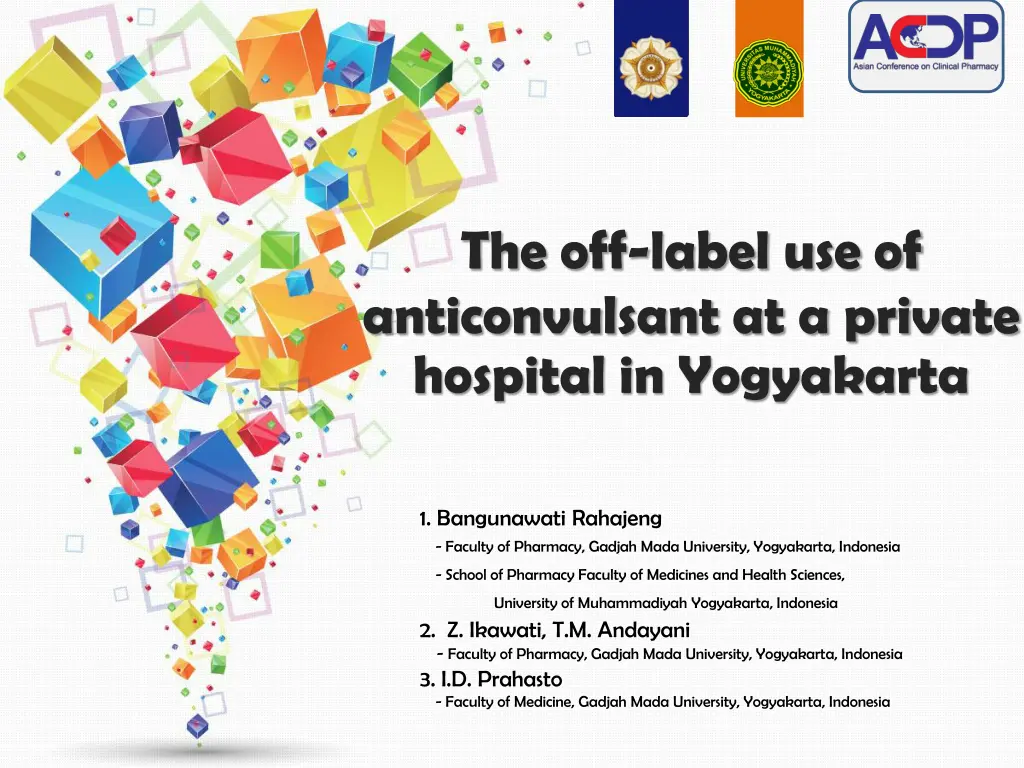
Anticonvulsant Off-Label Use Study in Yogyakarta Private Hospital
Discover the off-label use of anticonvulsants in a private hospital in Yogyakarta through a comprehensive study. The research evaluated prescription data from 2014, revealing insights into the prevalence and types of off-label indications. Gain valuable knowledge on the off-label use of anticonvulsants and its impact on patient care.
Download Presentation

Please find below an Image/Link to download the presentation.
The content on the website is provided AS IS for your information and personal use only. It may not be sold, licensed, or shared on other websites without obtaining consent from the author. If you encounter any issues during the download, it is possible that the publisher has removed the file from their server.
You are allowed to download the files provided on this website for personal or commercial use, subject to the condition that they are used lawfully. All files are the property of their respective owners.
The content on the website is provided AS IS for your information and personal use only. It may not be sold, licensed, or shared on other websites without obtaining consent from the author.
E N D
Presentation Transcript
The off-label use of anticonvulsant at a private hospital in Yogyakarta 1. Bangunawati Rahajeng - Faculty of Pharmacy, Gadjah Mada University, Yogyakarta, Indonesia - School of Pharmacy Faculty of Medicines and Health Sciences, University of Muhammadiyah Yogyakarta, Indonesia 2. Z. Ikawati, T.M. Andayani - Faculty of Pharmacy, Gadjah Mada University, Yogyakarta, Indonesia 3. I.D. Prahasto - Faculty of Medicine, Gadjah Mada University, Yogyakarta, Indonesia
OUTLINE Introduction Introductio n Introduction Methods Methods Methods Result and Discussion Result and discussion Discussion Result and Conclusion Conclusion Conclusion
INTRODUCTION Off-label : the use of licensed which is different from the description is written in the product information (Gazarian, 2007; Le Jeunne et al., 2013; Wittich et al., 2012). Anticonvulsants high off-label use Objective : to determine the off-label use of anticonvulsants in Yogyakarta
The off-label use of anticonvulsants worldwide 76.00% 74.00% 72.00% 70.00% 68.00% 66.00% 64.00% 62.00% Georgia Medicaid (Chen et.al, 2005) America (Stafford, 2008) Canada (Eguale et.al, 2012) OUTLINE OUTLINE
METHODS Observational, Retrospective Data : the prescription of anticonvulsants in 2014 from a private hospital in Yogyakarta. Population all patients (inpatients and outpatients) who receive anticonvulsants prescription Indication from medical record matched to an approved indication by NA-DFC Indonesia Strong evidence RCT, double-blind OUTLINE OUTLINE
RESULT AND DISCUSSION The Use of Anticonvulsants in 2014 400 350 300 250 On Label Off-Label 200 150 100 50 0 OXC PGB CBZ PHT VPA GBP Prescription : 5310, Patient : 1316 Total on-label use : 854 ( 64,89%), total off-label use : 462 (35, 11%)
Table 2. Off-label indication of anticonvulsants No The anticonvulsants Neurologic Psychiatric disorder Rheumatologic disorder Renal disorder Infection diseases Cardiovascular disorder Post neuropathy Oncologic disorder Endocrine disorder Gastrointestinal disorder Dental Gynecologic disorder Respiratory disorder Immunologic disorder Other indications Total use of *OXC PGB CBZ PHT VPA GBP Total % 1 & 29 24 40 173 32 13 311 67,32 2 5 8 6 24 19 62 13,42 3 4 5 1 20 3 3 3 8 7 2 2 4 10 2 27 21 17 5,84 4,54 3,68 6 Herpetic 1 3 4 0,87 7 8 9 1 2 1 1 2 1 3 3 2 0,65 0,65 0,43 10 11 12 13 14 37 1 1 60 1 54 1 1 1 5 225 37 1 49 2 1 1 1 7 462 0,43 0,22 0,22 0,22 1,51 100 OUTLINE OUTLINE
CONCLUSION The off-label use of anticonvulsants occurred in one-third patients receiving prescription of anticonvulsants, even though most of them was a lack of evidence. More attention must by paid on the efficacy and risk of side effect of the drug used. OUTLINE OUTLINE
OUTLINE OUTLINE
